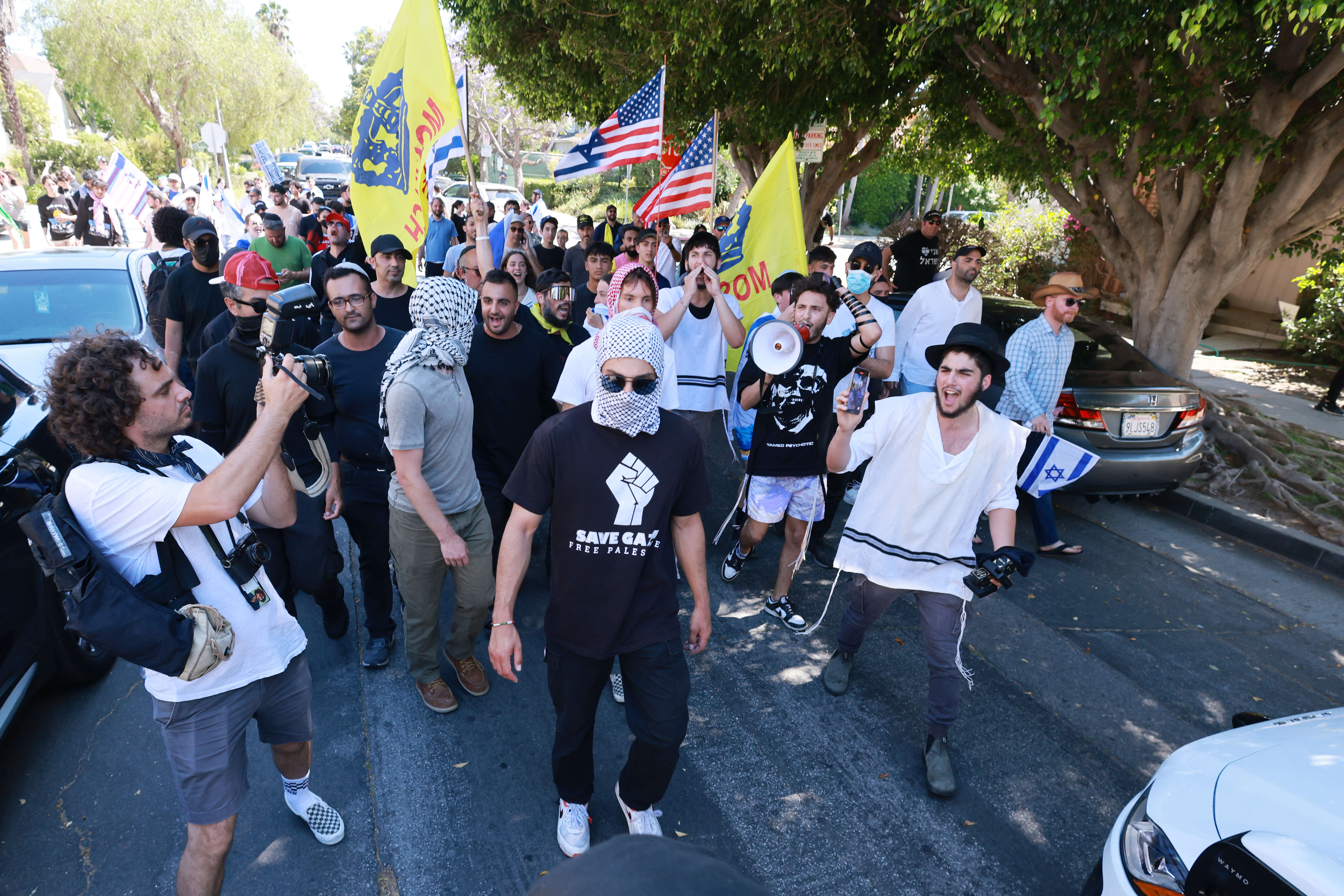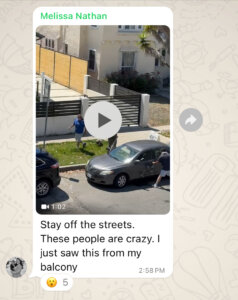The messy truth behind a viral video showing violence around anti-Israel protest at an LA synagogue
A lesson in media literacy for the age of WhatsApp and Instagram

Clashes between pro-Palestinian protesters and Israel supporters spilled over onto residential streets in Pico-Robertson on Sunday. Photo by David Swanson/AFP via Getty Images
LOS ANGELES – Hours after the ruckus outside Adas Torah died down on Sunday, Melissa Nathan, who lives two blocks away, was sent a video message showing a confrontation between a man in a kaffiyeh and someone walking his dog in front of her apartment building. An alarming message was overlaid on the video: “Wannabe Hamas and Hezbollah terrorists are hunting and bludgeoning Jews.”
Nathan recognized the clip; she was the one who recorded it on her phone a few hours before. But she hadn’t written that caption. And she had only posted it in a private chat group for young professionals at her own synagogue, urging them to stay inside to avoid the dueling protests outside Adas Torah, where a presentation on Israeli real estate had sparked the ire of pro-Palestinian activists. How had it spread all over Instagram?
The video shows the kaffiyeh-clad man reaching into his car for a pair of sticks the size of miniature baseball bats and then rushing at the dog-walker, who was wearing a blue shirt and a sun hat. Another activist steps between the two and, after a few seconds, the man in the kaffiyeh returns to his car.
Nathan, a 31-year-old job recruiter, didn’t think the video depicted Jews being hunted or bludgeoned. Watching the scene unfold from her balcony, she had not seen anyone get hit. And she had seen something viewers of the minute-long clip could not: Before she started recording, Nathan said, the man walking his dog had initiated the confrontation, calling the protester “f***ing disgusting.”
The Instagram post with the incendiary Hamas/Hezbollah message was viewed nearly half a million times and generated 1,300 comments in the coming days, making Nathan, as she put it, “really uncomfortable.”

“I had several friends text me saying, ‘Your video’s gone viral,’ and I was like, ‘I know, it’s not great,’” she told me. “It’s being misrepresented, and I don’t know that there’s anything I can do about it.’”
Stripped of context and filtered through a digital game of telephone, Nathan’s video told a story both simpler and more sinister than real life: Victims and villains, neatly separated into pro- and anti-Israel camps. With WhatsApp facilitating its amplification and Instagram rewarding it, that narrative became the prevailing account: antisemitic activists attacking Jews.
The protesters had targeted Adas Torah, an Orthodox shul in the heart of LA’s heavily Orthodox Pico-Robertson neighborhood, because it was hosting an Israeli real estate seminar. The company does sell some properties in the occupied West Bank, though people there said none were advertised at Sunday’s session.
In an interview a few days later, Nathan said she thought that protesting outside any synagogue was inherently antisemitic “whether it’s intended as such or not.” But that didn’t justify the inaccurate caption on her video.
She messaged the man who posted it on Instagram saying so. Nathan did not recognize the name, but it was a local public figure — Sam Yebri, a prominent attorney in LA’s Persian Jewish circles who ran unsuccessfully for Los Angeles City Council in 2022.
Nathan and Yebri, who had been referring to the fracas as “the Pico Pogrom” online, traded their very different impressions of what had gone down that day. He offered to take down his post, and she demurred, figuring the damage had already been done.
Neither, of course, had the full picture, as is so often the case these days in the toxic swirl of polarized politics, viral video clips, propaganda and misinformation that makes up much of the online discourse around the war in Gaza.
A protest turned violent
The demonstration outside the synagogue, like similar ones before it in New Jersey and Brooklyn, drew scores of activists to one of the country’s largest Orthodox Jewish communities. Pro-Israel Jews flocked to the same spot with their own flags and megaphones, echoing prior violent confrontations over the war in Gaza at UCLA and the San Fernando Valley, where one Jewish activist was killed.
Dozens of police officers were on hand and wearing riot gear, but they did little to separate the groups, and when the situation escalated to physical combat, they didn’t intervene. An LAPD official said Thursday the department had been “unprepared” for the protest. There was a single arrest on Sunday and the authorities said they are investigating two other reports of battery.
Yebri said in an interview Wednesday that he arrived at Adas Torah to find the synagogue surrounded by masked protesters, some wearing green Hamas headbands. He told me that he left after seeing protesters sucker-punching and pepper spraying Israel supporters and keying their cars.
Yebri continued to post updates on Instagram, where he has about 10,000 followers. He shared numerous videos that pro-Israel protesters sent from the scene, all showing violence by the pro-Palestinian side. One was Nathan’s clip of the kaffiyeh-wearer and the dog-walker.
“Someone shared it with me and described what happened,” Yebri said. “And I asked if I could share it, and I did.”
He said he couldn’t recall who shared it with him, or whether he had been the one to write the message about Hamas, Hezbollah, hunting and bludgeoning. The caption accompanying the post — “This is terrorism” — was his.
“It was not people protesting policy, not people who wanted to talk about dialogue or peace,” Yebri told me. “It was the people who were promoting it and on social media saying, ‘It’s time to escalate.’”
Yebri said that he did not see any violence from the pro-Israel contingent. Videos that have since circulated online show pro-Israel protesters throwing punches, spraying mace, shouting Islamophobic slurs and, in one case, hurling an egg in the face of someone on the other side.
Nathan did not leave home that day, but nonetheless saw and heard about behavior from pro-Israel protesters she found appalling. On the balcony next to hers, she said, a couple and their teenage son were shouting at pro-Palestinian protesters down on the street. Some parents brought small children in pro-Israel attire to the protest, which she, the mother of a toddler, thought was inappropriate.
“I think that both sides were spoiling for a fight,” she said.

More to the story
At least three members of Nathan’s synagogue WhatsApp group posted her video to their Instagram Stories, which may be how it found its way to Yebri,
When Nathan messaged him saying that his description of Jews being hunted was not what happened, he replied that it certainly was. His friend’s home on that same street had been vandalized, Yebri said. And he showed her a picture of a man with a mane of blond curls and a bloody nose. (Multiple people also said online that the man with the bloody nose had been instigating.)
Still, he offered to remove his post.
Nathan was conflicted. The confrontation she witnessed was scary, she said, and she thought people should see the video.
“No matter what the guy with the dog said to the men by the car, it didn’t warrant a very aggressive threat of a physical attack,” Nathan said. “I don’t believe that was justified in any way, and I think it is important that people know that that happened.”
Nathan was not the only person surprised to see her video online. The man walking his dog in the clip also reached out to Yebri, amazed that the incident had been recorded. To Yebri’s surprise, it was someone he knew — and the man had his own story to share: He said that minutes before he passed under Nathan’s balcony, he had been clocked by a different man wearing a kaffiyeh.
There was video of that, too, that Yebri said had been posted on the assailant’s own Instagram Story. Yebri showed me a still frame that seems to show a punch landing on the side of the dog-walker’s head as he passed a grocery store around the corner from Nathan’s apartment.
Yebri declined to identify the man who said he got hit. And the man declined, through Yebri, to be interviewed for this article.
Nathan, for her part, posted to her own Instagram on Sunday a message pushing back against what she called the “hyperbolic rhetoric” that Yebri had added to her video. She urged her followers not to believe everything they see on social media.
Yet when she spoke directly to friends about what happened, a few took Yebri’s side. Like him, they pointed out that Jewish people were beaten up on other streets, if not on hers.
“And I’m like, ‘Yes, but none of that’s the point,’” she told me. “People are looking to reaffirm their own judgments,” she added, “rather than looking for the truth.”
A message from our Publisher & CEO Rachel Fishman Feddersen

I hope you appreciated this article. Before you go, I’d like to ask you to please support the Forward’s award-winning, nonprofit journalism so that we can be prepared for whatever news 2025 brings.
At a time when other newsrooms are closing or cutting back, the Forward has removed its paywall and invested additional resources to report on the ground from Israel and around the U.S. on the impact of the war, rising antisemitism and polarized discourse.
Readers like you make it all possible. Support our work by becoming a Forward Member and connect with our journalism and your community.
— Rachel Fishman Feddersen, Publisher and CEO






























